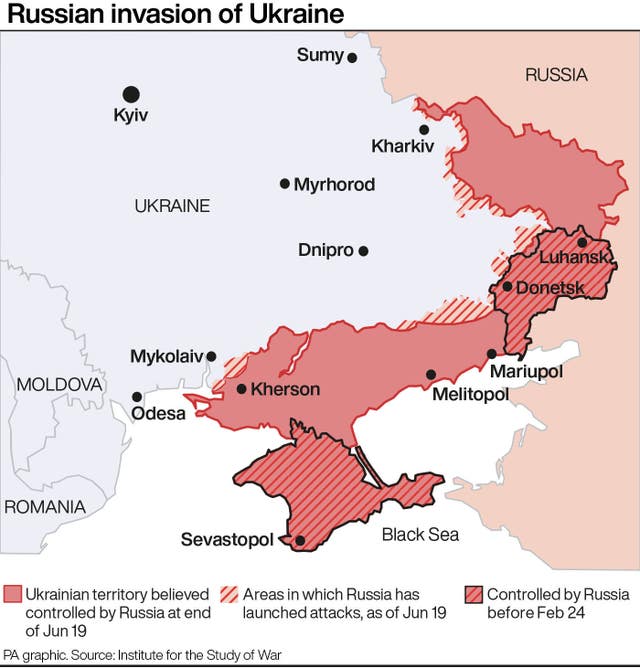Russia edges closer to swallowing up Ukraine’s last remaining Luhansk stronghold
Moscow-backed separatists are now in full control of Sievierodonetsk’s chemical plant that was the last Ukrainian holdout in the city.

Russian forces are seeking to swallow up the last remaining Ukrainian stronghold in the eastern Luhansk region following the withdrawal of Ukrainian troops from the charred ruins of Sievierodonetsk.
The military said Moscow-backed separatists were now in full control of the chemical plant that was the last Ukrainian holdout in the city.
Russia launched dozens of missiles on several areas across the country far from the heart of the eastern battles on Saturday.
The bombardment preceded a meeting between Russian President Vladimir Putin and Belarusian President Alexander Lukashenko, during which Mr Putin announced that Russia planned to supply Belarus with the Iskander-M missile system.
Russian defence ministry spokesman Igor Konashenkov said late on Saturday that Russian and Moscow-backed separatist forces now control Sievierodonetsk and the villages surrounding it.
He said the attempt by Ukrainian forces to turn the Azot plant into a “stubborn centre of resistance” had been thwarted.

He confirmed on Saturday that the city had fallen to Russian and separatist fighters, who he said were now trying to blockade Lysychansk from the south. The city lies across the river just to the west of Sievierodonetsk.
Capturing Lysychansk would give Russian forces control of every major settlement in the province, a significant step toward Russia’s aim of capturing the entire Donbas. The Russians and separatists control about half of Donetsk, the second province in the Donbas.

There was no immediate comment on the claim from the Ukrainian side.
Lysychansk and Sievierodonetsk have been the focal point of a Russian offensive aimed at capturing all of the Donbas and destroying the Ukrainian military defending it — the most capable and battle-hardened segment of the country’s armed forces.
Russian bombardment has reduced most of Sievierodonetsk to rubble and cut its population from 100,000 to 10,000.

A separatist representative, Ivan Filiponenko, said earlier on Saturday that its forces evacuated 800 civilians from the plant during the night, Interfax reported.
Ukrainian military analyst Oleg Zhdanov said some of the troops were heading for Lysychansk. But Russian moves to cut off Lysychansk will give those retreating troops little respite.
Some 600 miles to the west, four Russian cruise missiles fired from the Black Sea hit a “military object” in Yaroviv, Lviv regional governor Maksym Kozytskyy said.

About 30 Russian missiles were fired on the Zhytomyr region in central Ukraine on Saturday morning, killing one Ukrainian soldier, regional governor Vitaliy Buchenko said. He said all of the strikes were aimed at military targets.
In the northwest, two missiles hit a service station and auto repair centre in Sarny, killing three people and wounding four, the Rivne regional governor, Vitaliy Koval, said. He posted a picture of the destruction. Sarny is located about 30 miles south of the border with Belarus.

In the north, about 20 missiles were fired from Belarus into the Chernihiv region, the Ukrainian military said.
Ukraine’s military intelligence agency said the Russian bombers’ use of Belarusian airspace for the first time for Saturday’s attack was “directly connected to attempts by the Kremlin to drag Belarus into the war”.
Belarus hosts Russian military units and was used as a staging ground before Russia invaded Ukraine, but its own troops have not crossed the border.

He said the war was at a difficult stage, “when we know that the enemy will not succeed, when we understand that we can defend our country, but we don’t know how long it will take, how many more attacks, losses and efforts there will be before we can see that victory is already on our horizon”.
During his meeting in St Petersburg with Mr Lukashenko, Mr Putin told him the Iskander-M missile systems would be arriving in the coming months. He noted that they can fire either ballistic or cruise missiles and carry nuclear as well as conventional warheads.
Russia has launched several Iskander missiles into Ukraine during the war.





